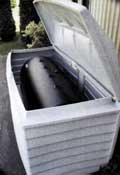Modern heating oil storage tanks are marvels of contemporary engineering. They have leak-proof inner walls of plastic or fiberglass and an outer wall of corrosion-resistant metal (for aboveground models) or a plastic/fiberglass outer wall (for underground models).
There are presently no federal or state laws regulating active underground tanks. However, if your clients are replacing a tank, make sure they check with their municipality for local replacement regulations and options.
Older underground tanks
For many years, home builders installed bare metal tanks for underground heating oil storage. Unfortunately, because metal corrodes, those tanks occasionally leak. Some tanks last 50 years or more, while others need to be replaced after 20. There is no set rule for metal tank longevity because so much depends upon how they were installed, the surrounding soil, water tables and salinity.
We recommend that every homeowner replace metal underground tanks with new, leak-proof plastic or fiberglass models. Encourage your clients to contact local oil dealers for estimates or recommendations on tank replacement options.
When selling a home, a new oil storage tank can make a huge difference in how quickly the home sells. It can also have a positive impact on the price.
Replacement options
If your current tank needs to be replaced, you have two good options.
1. Replace an old underground tank with a modern, corrosion-resistant underground tank. With today's technology, a new tank can be isolated from the ground, making it worry free.
|
2. Replace an underground tank with an aboveground tank. Aboveground tanks are normally smaller (275 gallons) and they can be customized for hard-to-fit places indoors. They can also be installed outside the home and hidden in a tank enclosure. |
|
Guidelines for replacement
If a homeowner decides to replace an underground tank with an aboveground tank, the buried tank must either be removed or properly closed and abandoned. To close the tank, it needs to be emptied, cleaned and then filled with an inert material such as sand or foam.
It is important to work with a licensed experienced professional when closing and abandoning an underground tank.
Before proceeding with a tank abandonment, homeowners should contact their municipal governments or local oil companies to find out about any codes or regulations that may affect the removal or abandonment of an underground tank.
How to tell if an oil tank
has been closed properly
The best resource is your town building inspector's office, which will have a record of the tank abandonment on file. Additionally, if a tank has been legally and properly abandoned, there will be no vent or fill pipe.
Underground tank testing
Frequently, a home buyer or seller is faced with a requirement from a lender or insurance company to have an underground oil tank tested. If this happens, here are two things to keep in mind.
- There are several tests that can be conducted on an underground tank, and the need for one test or another can vary. Often, a combination of tests is appropriate. To avoid confusion and to get a reliable assessment of which tests are best for your situation, consult a local oilheat dealer.
- Any testing on an underground tank should be conducted by a company that is certified to do tank testing.
Aboveground tank inspection
Here are some things to check when listing or selling a home with oilheat:
- Make sure the oil tank's fill pipe and vent pipe are metal, not plastic, and that they have caps.
- Look for leakage from and around tank fittings, valves, filters or the tank's gauge.
- Make sure the tank legs are in good condition and that the tank belly doesn't touch the ground.
- Look for signs of corrosion.
For more information about oil tank options, call your local oilheat dealer.
© 2009 Warm Thoughts Communications, Inc.

